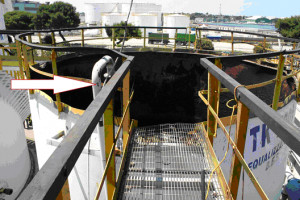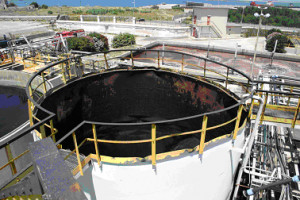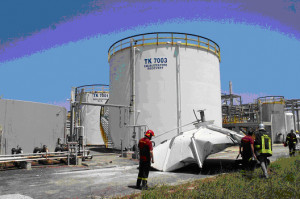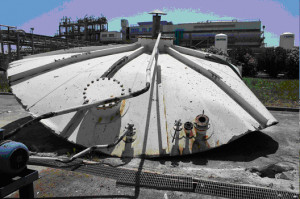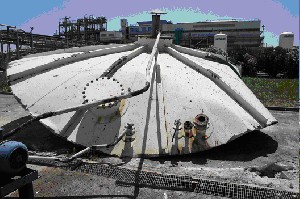An explosion occurred around noon while conducting hot work (with a disc saw) on a 320-m³ fixed-roof tank at a pharmaceutical plant employing 240 personnel. The tank cover was blasted 20 m away and the subcontractor performing cutting works was killed. Three other subcontractors and a plant employee were severely burnt and injured by the shock wave. Notified by neighbours and not by the operator, fire-fighters arrived on the scene 15 min after the explosion and promptly extinguished the fire. Municipal and provincial authorities as well as Regional Environmental Agency officials were duly informed of the accident; the operator issued two press releases.
Under normal operations, the tank collected a liquid fermentation residue composed of water and micro-organisms assumed dead. The initial design included an air injection circuit at the tank bottom and a suction circuit at the level of its vent, in order to homogenise effluent. That system was shut down (10 years prior to the accident) – it was considered redundant as a mixing baffle had already been installed at the tank bottom – but this resulted in the formation of an anaerobic atmosphere. Anaerobic fermentation of both the liquid phase and a solid deposit, which had not been identified by the operator either during initial design or before undertaking renovations, was thus responsible for generating explosive gases (especially hydrogen and methane), as indicated in the operator’s post-accident analysis. The production of sparks while the subcontractor was working adjacent to the air duct, which had been temporarily disconnected but not sealed, triggered this explosion. Several deficiencies were observed regarding works organisation, namely: lack of precision in written procedures governing hot works and poor understanding of procedures among employees and subcontractors, plus inadequate subcontractor expertise (as demonstrated by failure to plug the duct).
These recorded deficiencies led the Regional Environmental Agency to order closure of a portion of the plant for 2 weeks. In July 2012, upon completion of the judicial investigation, charges were brought against 15 plant personnel, including the foreman and HSE (Health, Safety & Environment) Manager.
Download the detailed report in .pdf format (2.9 Mb)



